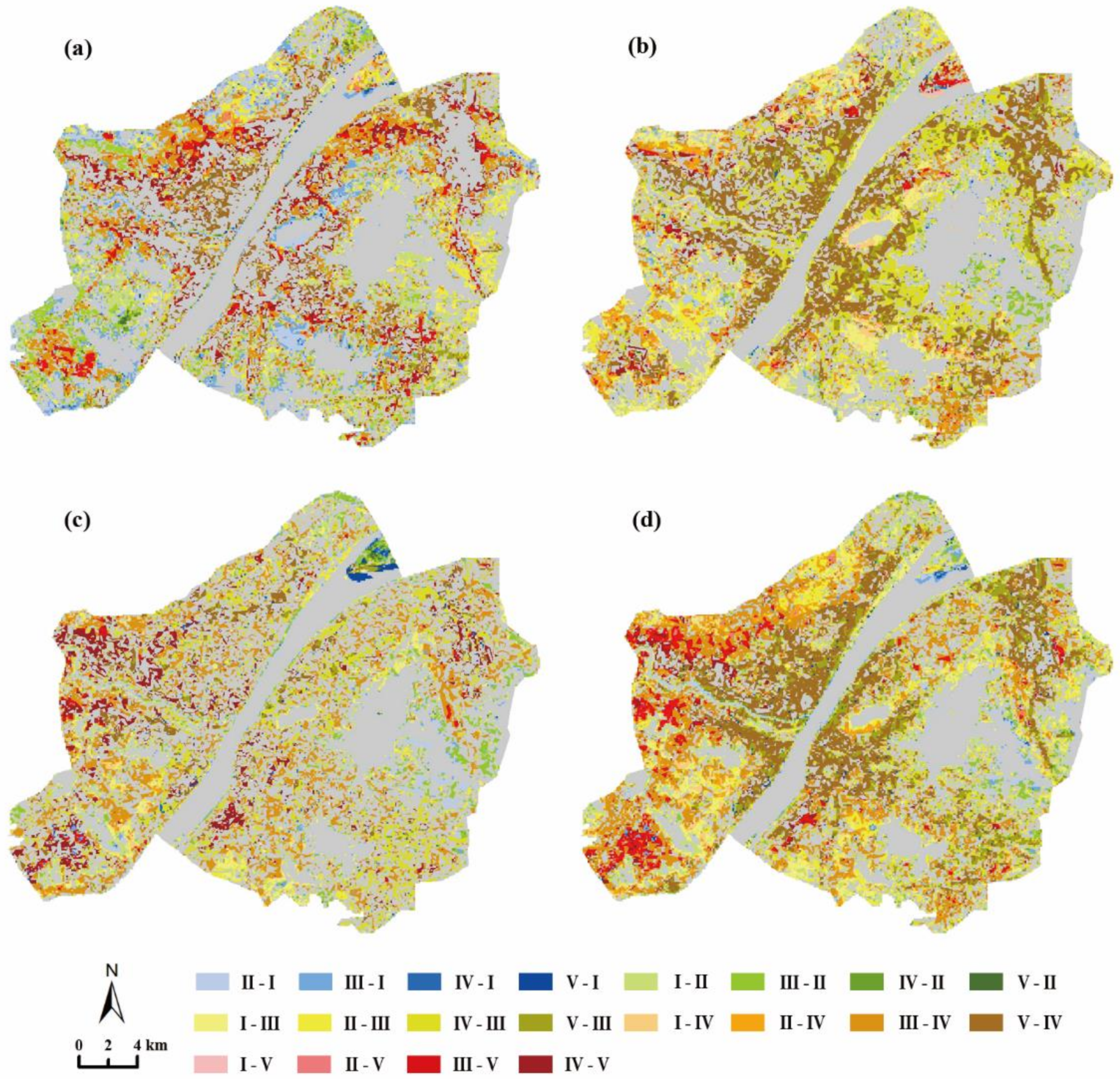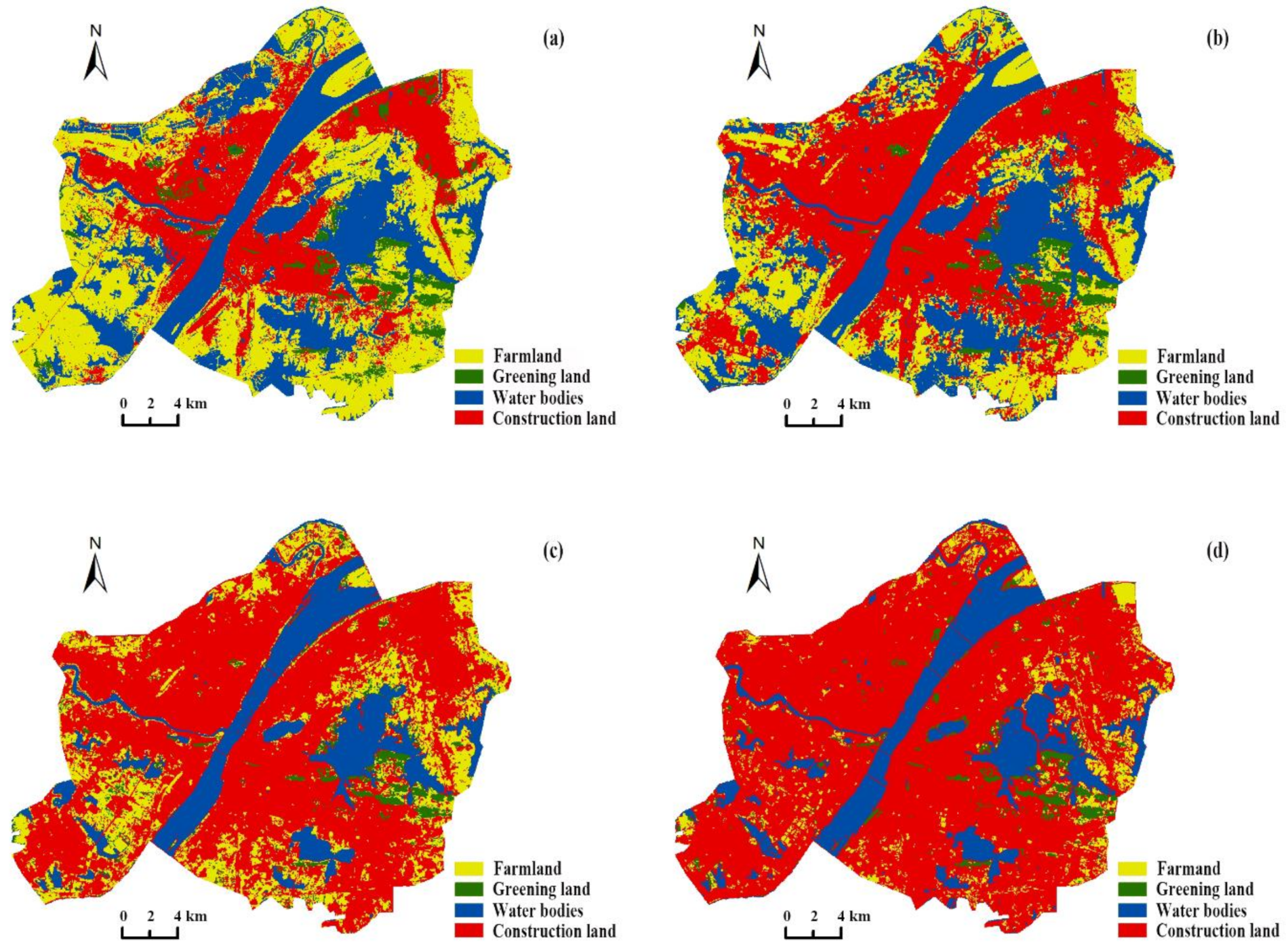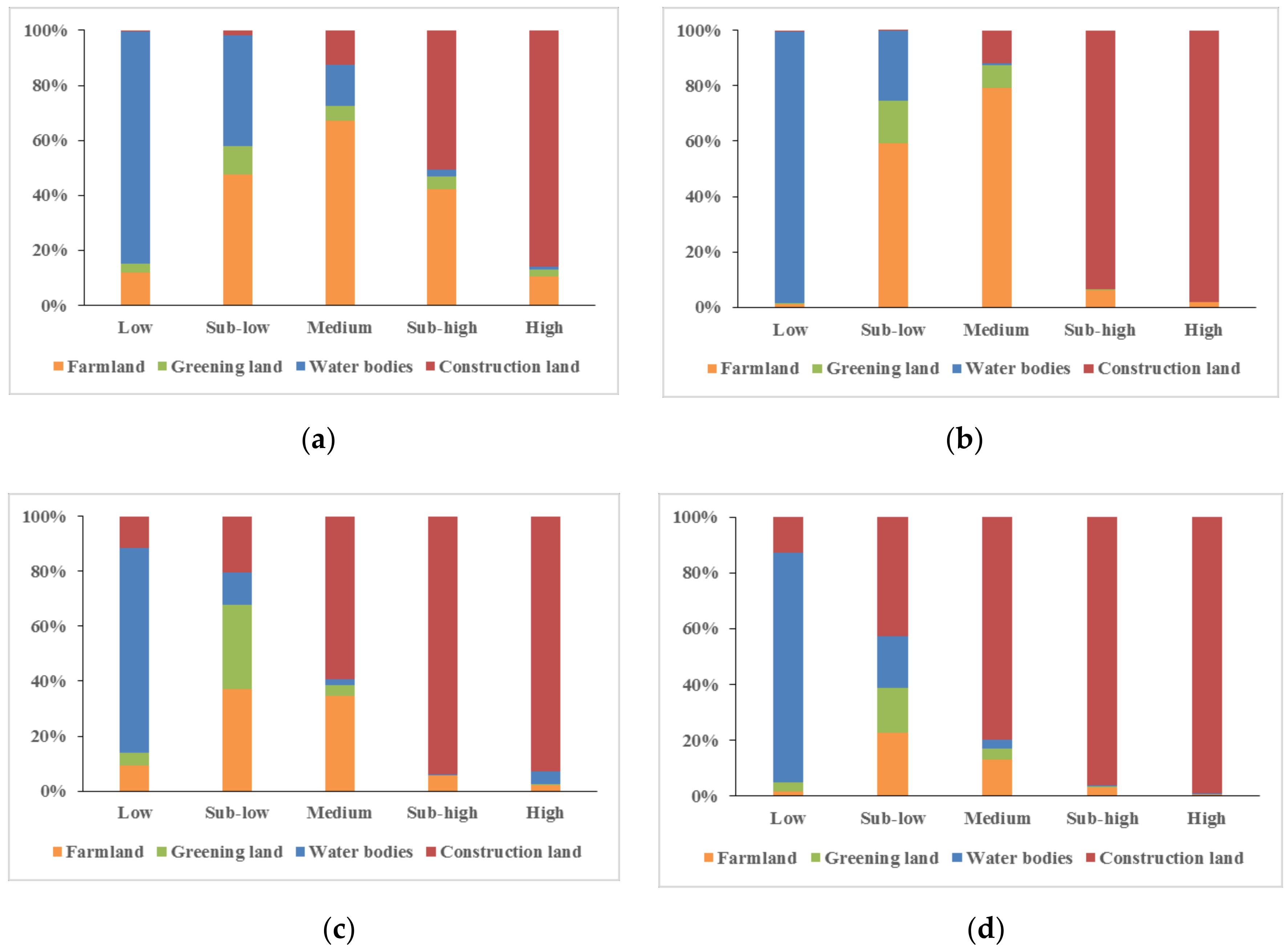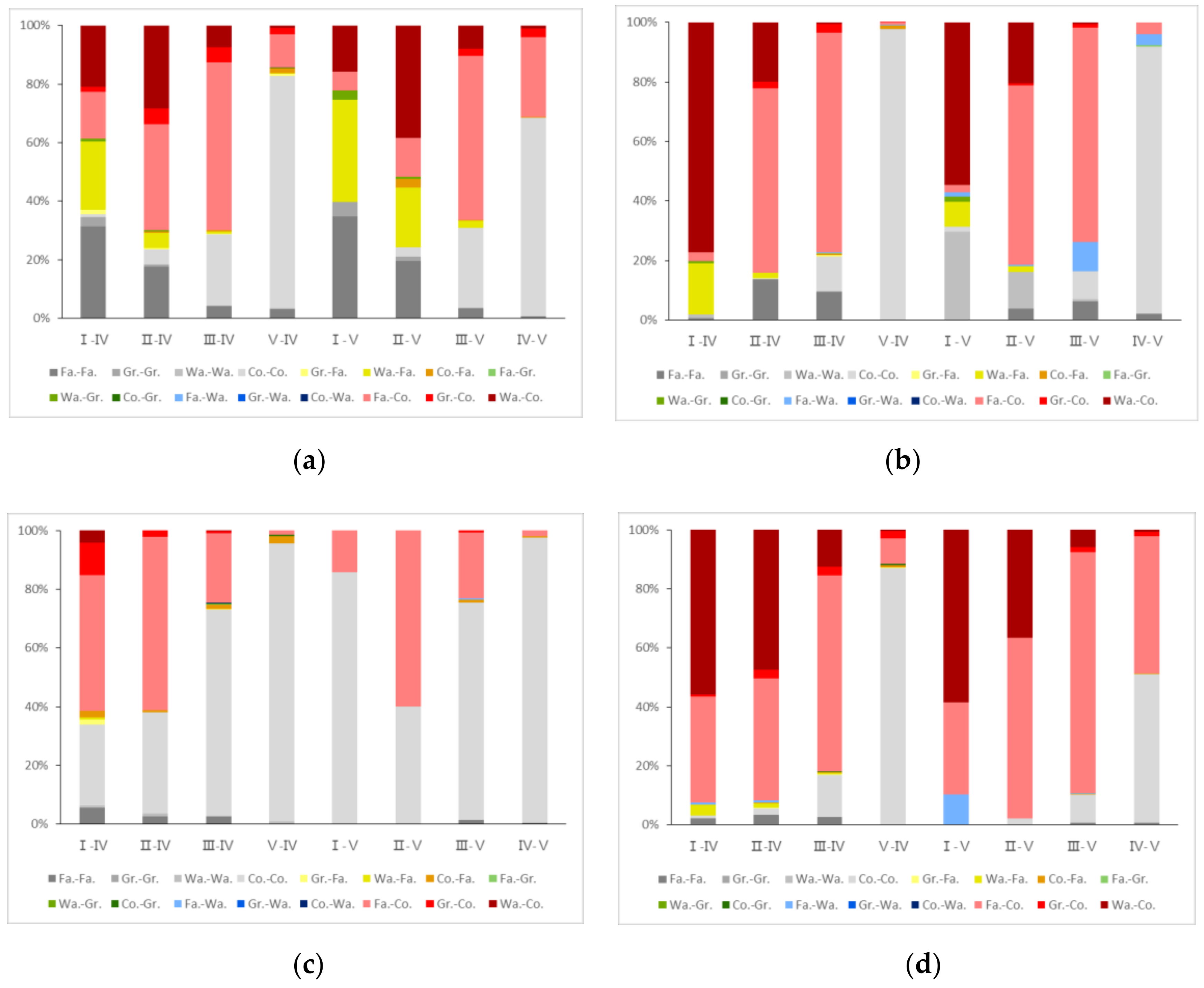Monitoring Spatiotemporal Evolution of Urban Heat Island Effect and Its Dynamic Response to Land Use/Land Cover Transition in 1987–2016 in Wuhan, China
Abstract
:1. Introduction
2. Materials and Methods
2.1. Study Area
2.2. Data Pre-Processing and Land Use/Land Cover Classification
2.3. LST Derivation
2.4. Modeling the UHI and LULC Variation
3. Results and Discussion
3.1. Spatiotemporal Variation of Urban Thermal Characteristics
3.1.1. Spatial Distribution of Different Surface Temperature Levels
3.1.2. LST Variation during 1987–2016
3.2. Spatiotemporal Variation of Land Use/Land Cover
3.2.1. LULC Spatial Distribution in Different Study Years
3.2.2. LULC Variation during 1987–2016
3.3. Response of Urban Heat Island Effect to Land Use/Land Cover Change
3.3.1. Spatial Correlation between LULC Types and NLST Levels
3.3.2. Dynamic Response of UHI Evolution to LULC Transition
4. Conclusions
Author Contributions
Funding
Conflicts of Interest
References
- Salata, F.; Golasi, I.; Petitti, D.; Vollaro, E.D.L.; Coppi, M.; Vollaro, A.D.L. Relating microclimate, human thermal comfort and health during heat waves: An analysis of heat island mitigation strategies through a case study in an urban outdoor environment. Sust. Cities Soc. 2017, 30, 79–96. [Google Scholar] [CrossRef]
- Wong, L.P.; Alias, H.; Aghamohammadi, N.; Aghazadeh, S.; Sulaiman, N.M.N. Urban heat island experience, control measures and health impact: A survey among working community in the city of Kuala Lumpur. Sust. Cities Soc. 2017, 35, 660–668. [Google Scholar] [CrossRef]
- Santamouris, M. Recent progress on urban overheating and heat island research. Integrated assessment of the energy, environmental, vulnerability and health impact. Synergies with the global climate change. Energy Build. 2020, 207, 109482. [Google Scholar] [CrossRef]
- Kolokotroni, M.; Giannitsaris, I.; Watkins, R. The effect of the London urban heat island on building summer cooling demand and night ventilation strategies. Sol. Energy 2006, 80, 383–392. [Google Scholar] [CrossRef]
- Li, X.; Zhou, X.; Yu, S.; Li, H.; Li, W. Urban heat island impacts on building energy consumption: A review of approaches and findings. Energy 2019, 174, 407–419. [Google Scholar] [CrossRef]
- Yang, X.; Peng, L.L.H.; Jiang, Z.; Chen, Y.; Yao, L.; He, Y.; Xu, T. Impact of urban heat island on energy demand in buildings: Local climate zones in Nanjing. Appl. Energy 2020, 260, 114279. [Google Scholar] [CrossRef]
- Han, S.; Bian, H.; Tie, X.; Xie, Y.; Sun, M.; Liu, A. Impact of nocturnal planetary boundary layer on urban air pollutants: Measurements from a 250-m tower over Tianjin, China. J. Hazard. Mater. 2009, 162, 264–269. [Google Scholar] [CrossRef]
- Abbassi, Y.; Ahmadikia, H.; Baniasadi, E. Prediction of pollution dispersion under urban heat island circulation for different atmospheric stratification. Build. Environ. 2019, 168, 106374. [Google Scholar] [CrossRef]
- Doan, V.Q.; Kusaka, H.; Nguyen, T.M. Roles of past, present, and future land use and anthropogenic heat release changes on urban heat island effects in Hanoi, Vietnam: Numerical experiments with a regional climate model. Sust. Cities Soc. 2019, 47, 101479. [Google Scholar] [CrossRef]
- Basu, R.; Samet, J.M. Relation between elevated ambient temperature and mortality: A review of the epidemiologic evidence. Epidemiol. Rev. 2002, 24, 190–202. [Google Scholar] [CrossRef]
- Hattis, D.; Ogneva-Himmelberger, Y.; Ratick, S. The spatial variability of heat-related mortality in Massachusetts. Appl. Geogr. 2012, 33, 45–52. [Google Scholar] [CrossRef]
- Johnson, D.P.; Stanforth, A.; Lulla, V.; Luber, G. Developing an applied extreme heat vulnerability index utilizing socioeconomic and environmental data. Appl. Geogr. 2012, 35, 23–31. [Google Scholar] [CrossRef]
- Wang, D.; Lau, K.K.-L.; Ren, C.; Goggins, W.B.; Shi, Y.; Ho, H.C.; Lee, T.-C.; Lee, L.-S.; Woo, J.; Ng, E. The impact of extremely hot weather events on all-cause mortality in a highly urbanized and densely populated subtropical city: A 10-year time-series study (2006–2015). Sci. Total Environ. 2019, 690, 923–931. [Google Scholar] [CrossRef] [PubMed]
- Ward, K.; Lauf, S.; Kleinschmit, B.; Endlicher, W. Heat waves and urban heat islands in Europe: A review of relevant drivers. Sci. Total Environ. 2016, 569–570, 527–539. [Google Scholar] [CrossRef] [PubMed]
- Deilami, K.; Kamruzzaman, M.; Liu, Y. Urban heat island effect: A systematic review of spatio-temporal factors, data, methods, and mitigation measures. Int. J. Appl. Earth Obs. Geoinf. 2018, 67, 30–42. [Google Scholar] [CrossRef]
- Sharma, R.; Ghosh, A.; Joshi, P.K. Spatio-temporal footprints of urbanisation in Surat, the Diamond City of India (1990–2009). Environ. Monit. Assess. 2013, 185, 3313–3325. [Google Scholar] [CrossRef] [PubMed]
- Morris, K.I.; Chan, A.; Morris, K.J.K.; Ooi, M.C.G.; Oozeer, M.Y.; Abakr, Y.A.; Nadzir, M.S.M.; Mohammed, I.Y.; Al-Qrimli, H.F. Impact of urbanization level on the interactions of urban area, the urban climate, and human thermal comfort. Appl. Geogr. 2017, 79, 50–72. [Google Scholar] [CrossRef]
- Salvati, L.; Zambon, I.; Chelli, F.M.; Serra, P. Do spatial patterns of urbanization and land consumption reflect different socioeconomic contexts in Europe? Sci. Total Environ. 2018, 625, 722–730. [Google Scholar] [CrossRef]
- Chuai, X.; Huang, X.; Wu, C.; Li, J.; Lu, Q.; Qi, X.; Zhang, M.; Zuo, T.; Lu, J. Land use and ecosystems services value changes and ecological land management in coastal Jiangsu, China. Habitat Int. 2016, 57, 164–174. [Google Scholar] [CrossRef]
- Asabere, S.B.; Acheampong, R.A.; Ashiagbor, G.; Beckers, S.C.; Keck, M.; Erasmi, S.; Schanze, J.; Sauer, D. Urbanization, land use transformation and spatio-environmental impacts: Analyses of trends and implications in major metropolitan regions of Ghana. Land Use Pol. 2020, 96, 104707. [Google Scholar] [CrossRef]
- Reba, M.; Seto, K.C. A systematic review and assessment of algorithms to detect, characterize, and monitor urban land change. Remote Sens. Environ. 2020, 242, 111739. [Google Scholar] [CrossRef]
- Rotem-Mindali, O.; Michael, Y.; Helman, D.; Lensky, I.M. The role of local land-use on the urban heat island effect of Tel Aviv as assessed from satellite remote sensing. Appl. Geogr. 2015, 56, 145–153. [Google Scholar] [CrossRef]
- Jamei, E.; Rajagopalan, P.; Seyedmahmoudian, M.; Jamei, Y. Review on the impact of urban geometry and pedestrian level greening on outdoor thermal comfort. Renew. Sust. Energ. Rev. 2016, 54, 1002–1017. [Google Scholar] [CrossRef]
- Berihun, M.L.; Tsunekawa, A.; Haregeweyn, N.; Meshesha, D.T.; Adgo, E.; Tsubo, M.; Masunaga, T.; Fenta, A.A.; Sultan, D.; Yibeltal, M. Exploring land use/land cover changes, drivers and their implications in contrasting agro-ecological environments of Ethiopia. Land Use Pol. 2019, 87, 104052. [Google Scholar] [CrossRef]
- Sejati, A.W.; Buchori, I.; Rudiarto, I. The spatio-temporal trends of urban growth and surface urban heat islands over two decades in the Semarang Metropolitan Region. Sust. Cities Soc. 2019, 46, 101432. [Google Scholar] [CrossRef]
- Singh, P.; Kikon, N.; Verma, P. Impact of land use change and urbanization on urban heat island in Lucknow city, Central India. A remote sensing based estimate. Sust. Cities Soc. 2017, 32, 100–114. [Google Scholar] [CrossRef]
- Grigoraș, G.; Urițescu, B. Land Use/Land Cover changes dynamics and their effects on Surface Urban Heat Island in Bucharest, Romania. Int. J. Appl. Earth Obs. Geoinf. 2019, 80, 115–126. [Google Scholar] [CrossRef]
- Xie, Q.; Zhou, Z.; Teng, M.; Wang, P. A multi-temporal Landsat TM data analysis of the impact of land use and land cover changes on the urban heat island effect. J. Food Agric. Environ. 2012, 10, 803–809. [Google Scholar]
- Silva, J.S.; Silva, R.M.D.; Santos, C.A.G. Spatiotemporal impact of land use/land cover changes on urban heat islands: A case study of Paço do Lumiar, Brazil. Build. Environ. 2018, 136, 279–292. [Google Scholar] [CrossRef]
- Yu, Z.; Yao, Y.; Yang, G.; Wang, X.; Vejre, H. Strong contribution of rapid urbanization and urban agglomeration development to regional thermal environment dynamics and evolution. For. Ecol. Manag. 2019, 446, 214–225. [Google Scholar] [CrossRef]
- Li, J.; Song, C.; Cao, L.; Zhu, F.; Meng, X.; Wu, J. Impacts of landscape structure on surface urban heat islands: A case study of Shanghai, China. Remote Sens. Environ. 2011, 115, 3249–3263. [Google Scholar] [CrossRef]
- Hou, H.; Estoque, R.C. Detecting cooling effect of landscape from composition and configuration: An Urban Heat Island study on Hangzhou. Urban For. Urban Green. 2020, 53, 126719. [Google Scholar] [CrossRef]
- Yuan, F.; Bauer, M.E. Comparison of impervious surface area and normalized difference vegetation index as indicators of surface urban heat island effects in Landsat imagery. Remote Sens. Environ. 2007, 106, 375–386. [Google Scholar] [CrossRef]
- Mathew, A.; Khandelwal, S.; Kaul, N. Spatial and temporal variations of urban heat island effect and the effect of percentage impervious surface area and elevation on land surface temperature: Study of Chandigarh city, India. Sust. Cities Soc. 2016, 26, 264–277. [Google Scholar] [CrossRef]
- Weng, Q.; Lu, D.; Schubring, J. Estimation of land surface temperature-vegetation abundance relationship for urban heat island studies. Remote Sens. Environ. 2004, 89, 467–483. [Google Scholar] [CrossRef]
- Raynolds, M.K.; Comiso, J.C.; Walker, D.A.; Verbyla, D. Relationship between satellite-derived land surface temperatures, arctic vegetation types, and NDVI. Remote Sens. Environ. 2008, 112, 1884–1894. [Google Scholar] [CrossRef]
- Zhang, Y.; Odeh, I.O.A.; Han, C. Bi-temporal characterization of land surface temperature in relation to impervious surface area, NDVI and NDBI, using a sub-pixel image analysis. Int. J. Appl. Earth Obs. Geoinf. 2009, 11, 256–264. [Google Scholar] [CrossRef]
- Chen, X.-L.; Zhao, H.-M.; Li, P.-X.; Yin, Z.-Y. Remote sensing image-based analysis of the relationship between urban heat island and land use/cover changes. Remote Sens. Environ. 2006, 104, 133–146. [Google Scholar] [CrossRef]
- Gago, E.J.; Roldan, J.; Pacheco-Torres, R.; Ordóñez, J. The city and urban heat islands: A review of strategies to mitigate adverse effects. Renew. Sust. Energ. Rev. 2013, 25, 749–758. [Google Scholar] [CrossRef]
- Li, X.; Zhou, X.; Asrar, G.R.; Imhoff, M.; Li, X. The surface urban heat island response to urban expansion: A panel analysis for the conterminous United States. Sci. Total Environ. 2017, 605–606, 426–435. [Google Scholar] [CrossRef]
- Zhou, X.; Chen, H. Impact of urbanization-related land use land cover changes and urban morphology changes on the urban heat island phenomenon. Sci. Total Environ. 2018, 635, 1467–1476. [Google Scholar] [CrossRef] [PubMed]
- Sun, Y.; Gao, C.; Li, J.; Wang, R.; Liu, J. Evaluating urban heat island intensity and its associated determinants of towns and cities continuum in the Yangtze River Delta Urban Agglomerations. Sust. Cities Soc. 2019, 50, 101659. [Google Scholar] [CrossRef]
- Zhang, H.; Qi, Z.-F.; Ye, X.-Y.; Cai, Y.-B.; Ma, W.-C.; Chen, M.-N. Analysis of land use/land cover change, population shift, and their effects on spatiotemporal patterns of urban heat islands in metropolitan Shanghai, China. Appl. Geogr. 2013, 44, 121–133. [Google Scholar] [CrossRef]
- Son, N.-T.; Chen, C.-F.; Chen, C.-R.; Thanh, B.-X.; Vuong, T.-H. Assessment of urbanization and urban heat islands in Ho Chi Minh City, Vietnam using Landsat data. Sust. Cities Soc. 2017, 30, 150–161. [Google Scholar] [CrossRef]
- Shifaw, E.; Sha, J.; Li, X.; Bao, Z.; Zhou, Z. An insight into land-cover changes and their impacts on ecosystem services before and after the implementation of a comprehensive experimental zone plan in Pingtan island, China. Land Use Pol. 2019, 82, 631–642. [Google Scholar] [CrossRef]
- Deilami, K.; Kamruzzaman, M.; Hayes, J.F. Correlation or causality between Land Cover Patterns and the Urban Heat Island Effect? Evidence from Brisbane, Australia. Remote Sens. 2016, 8, 716. [Google Scholar] [CrossRef] [Green Version]
- Xu, H. Retrieval of the reflectance and land surface temperature of the newly-launched Landsat 8 satellite. Chin. J. Geophys. 2015, 58, 741–747. (In Chinese) [Google Scholar]
- Jiménez-Muñoz, J.C.; Sobrino, J.A.; Skokovi’, D.; Mattar, C.; Cristóbal, J. Land Surface Temperature retrieval eethods from Landsat-8 thermalinfrared sensor data. IEEE Geosci. Remote Sens. Lett. 2014, 11, 1840–1843. [Google Scholar] [CrossRef]
- Sobrino, J.A.; Jimene-Munoz, J.C.; Paolini, L. Land surface temperature retrieval from Landsat TM5. Remote Sens. Environ. 2004, 90, 434–440. [Google Scholar] [CrossRef]
- Chander, G.; Markham, B. Revised Landsat-5 TM radiometric calibration procedures and postcalibration dynamic ranges. IEEE Trans. Geosci. Remote Sens. 2003, 41, 2674–2677. [Google Scholar] [CrossRef] [Green Version]
- Chavez, P.S. Image-based atmospheric corrections-revisited and improved. Photogramm. Eng. Remote Sens. 1996, 62, 1025–1036. [Google Scholar]







| Sensor | Date of Acquisition | Path/Row | Resolution (m) | Cloud Cover (%) | Thermal Infrared Band |
|---|---|---|---|---|---|
| Landsat-5 TM | 1987/09/26 | 123/039 | 30/120 | 0.00 | band 6 |
| Landsat-5 TM | 1996/10/04 | 123/039 | 30/120 | 0.01 | band 6 |
| Landsat-5 TM | 2007/07/31 | 123/039 | 30/120 | 0.47 | band 6 |
| Landsat-8 OLI/TIRS | 2016/07/23 | 123/039 | 30/100 | 0.41 | band 10/band 11 |
| NLST Level | 1987 | 1996 | 2007 | 2016 | |||||
|---|---|---|---|---|---|---|---|---|---|
| Area | % | Area | % | Area | % | Area | % | ||
| I | Low | 149.8 | 22.0 | 181.9 | 26.7 | 130.6 | 19.2 | 117.1 | 17.2 |
| II | Sub-low | 74.3 | 10.9 | 58.9 | 8.6 | 31.2 | 4.6 | 44.6 | 6.5 |
| III | Medium | 234.8 | 34.4 | 155.3 | 22.8 | 257.9 | 37.8 | 239.2 | 35.1 |
| IV | Sub-high | 95.3 | 14.0 | 145.1 | 21.3 | 216.2 | 31.7 | 234.4 | 34.4 |
| V | High | 127.8 | 18.7 | 140.8 | 20.7 | 46.1 | 6.8 | 46.9 | 6.9 |
| NLST Level | 1987–1996 | 1996–2007 | 2007–2016 | 1987–2016 | |||||
|---|---|---|---|---|---|---|---|---|---|
| Area Change | % | Area Change | % | Area Change | % | Area Change | % | ||
| I | Low | 32.2 | 21.5 | −51.4 | −28.2 | −13.5 | −10.3 | −32.7 | −21.8 |
| II | Sub-low | −15.4 | −20.8 | −27.7 | −47.0 | 13.4 | 42.9 | −29.8 | −40.1 |
| III | Medium | −79.6 | −33.9 | 102.7 | 66.1 | −18.8 | −7.3 | 4.3 | 1.8 |
| IV | Sub-high | 49.8 | 52.3 | 71.1 | 49.0 | 18.2 | 8.4 | 139.1 | 145.9 |
| V | High | 13.1 | 10.2 | −94.7 | −67.2 | 0.7 | 1.6 | −80.9 | −63.3 |
| Period | NLST Level | Low | Sub-Low | Medium | Sub-High | High | Total |
|---|---|---|---|---|---|---|---|
| 1987–1996 | Low | - | 11.6 | 10.0. | 1.2 | 0.6 | 23.4 |
| Sub-low | 27.0 | - | 27.0 | 4.5 | 1.3 | 59.8 | |
| Medium | 26.6 | 29.2 | - | 67.7 | 18.0 | 141.5 | |
| Sub-high | 1.1 | 2.7 | 19.0 | - | 27.8 | 50.5 | |
| High | 0.9 | 0.8 | 6.1 | 27.0 | - | 34.7 | |
| Total | 55.6 | 44.3 | 61.9 | 100.4 | 47.7 | - | |
| 1996–2007 | Low | - | 9.9 | 37.7 | 10.4 | 2.3 | 60.3 |
| Sub-low | 4.4 | - | 31.1 | 12.1 | 1.6 | 49.2 | |
| Medium | 3.4 | 10.0 | - | 39.6 | 6.1 | 59.1 | |
| Sub-high | 0.8 | 1.4 | 66.9 | - | 8.6 | 77.7 | |
| High | 0.3 | 0.2 | 26.1 | 86.6 | - | 113.3 | |
| Total | 9.0 | 21.5 | 161.8 | 148.8 | 18.6 | - | |
| 2007–2016 | Low | - | 12.5 | 13.1 | 3.0 | 0.1 | 28.6 |
| Sub-low | 5.0 | - | 12.6 | 2.8 | 0.1 | 20.4 | |
| Medium | 5.1 | 19.1 | - | 79.2 | 4.2 | 107.6 | |
| Sub-high | 2.8 | 1.6 | 56.9 | - | 24.4 | 85.7 | |
| High | 2.2 | 0.6 | 6.3 | 18.9 | - | 28.0 | |
| Total | 15.1 | 33.8 | 88.8 | 103.8 | 28.7 | - | |
| 1987–2016 | Low | - | 17.2 | 24.5 | 7.6 | 0.3 | 49.5 |
| Sub-low | 7.6 | - | 35.9 | 16.3 | 1.8 | 61.6 | |
| Medium | 5.8 | 12.4 | - | 89.4 | 18.9 | 126.4 | |
| Sub-high | 1.3 | 1.5 | 36.6 | - | 8.3 | 47.7 | |
| High | 2.1 | 0.8 | 33.8 | 73.5 | - | 110.1 | |
| Total | 16.8 | 31.8 | 130.8 | 186.7 | 29.2 | - |
| LULC Category | 1987 | 1996 | 2007 | 2016 | ||||
|---|---|---|---|---|---|---|---|---|
| Area | % | Area | % | Area | % | Area | % | |
| Farmland (Fa.) | 264.5 | 38.8 | 171.9 | 25.2 | 126.6 | 18.6 | 51.1 | 7.5 |
| Greening land (Gr.) | 33.3 | 4.9 | 23.0 | 3.4 | 26.4 | 3.9 | 21.0 | 3.1 |
| Water bodies (Wa.) | 194.7 | 28.6 | 194.1 | 28.5 | 108.9 | 16.0 | 112.5 | 16.5 |
| Construction land (Co.) | 189.5 | 27.8 | 293.1 | 43.0 | 420.1 | 61.6 | 497.4 | 72.9 |
| LULC Category | 1987–1996 | 1996–2007 | 2007–2016 | 1987–2016 | ||||
|---|---|---|---|---|---|---|---|---|
| Area Change | % | Area Change | % | Area Change | % | Area Change | % | |
| Farmland (Fa.) | −92.7 | −35.0 | −45.3 | −26.4 | −75.5 | −59.6 | −213.4 | −80.7 |
| Greening land (Gr.) | −10.3 | −31.0 | 3.4 | 14.8 | −5.4 | −20.4 | −12.3 | −36.9 |
| Water bodies (Wa.) | −0.6 | −0.3 | −85.2 | −43.9 | 3.6 | 3.3 | −82.2 | −42.2 |
| Construction land (Co.) | 103.6 | 54.7 | 127.0 | 43.4 | 77.3 | 18.4 | 307.9 | 162.5 |
| Period | LULC Category | Farmland | Greening Land | Water Bodies | Construction Land | Total |
|---|---|---|---|---|---|---|
| 1987–1996 | Farmland | - | 5.8 | 28.6 | 90.4 | 124.8 |
| Greening land | 7.2 | - | 1.3 | 11.0 | 19.5 | |
| Water bodies | 17.5 | 1.1 | - | 14.3 | 32.9 | |
| Construction land | 7.5 | 2.2 | 2.4 | - | 12.1 | |
| Total | 32.2 | 9.1 | 32.3 | 115.7 | - | |
| 1996–2007 | Farmland | - | 5.6 | 4.5 | 92.4 | 102.5 |
| Greening land | 3.8 | - | 0.2 | 7.7 | 11.7 | |
| Water bodies | 34.3 | 7.5 | - | 48.5 | 90.3 | |
| Construction land | 19.1 | 2.0 | 0.5 | - | 21.5 | |
| Total | 57.2 | 15.1 | 5.2 | 148.5 | - | |
| 2007–2016 | Farmland | - | 3.8 | 2.1 | 88.1 | 94.0 |
| Greening land | 2.8 | - | 0.7 | 10.8 | 14.3 | |
| Water bodies | 0.5 | 0.3 | - | 6.1 | 6.9 | |
| Construction land | 15.3 | 4.8 | 7.6 | - | 27.8 | |
| Total | 18.5 | 9.0 | 10.5 | 105.1 | - | |
| 1987–2016 | Farmland | - | 4.9 | 5.7 | 218.3 | 228.9 |
| Greening land | 3.5 | - | 0.1 | 18.4 | 22.0 | |
| Water bodies | 7.9 | 1.6 | - | 78.9 | 88.5 | |
| Construction land | 4.1 | 3.2 | 0.4 | - | 7.7 | |
| Total | 15.5 | 9.7 | 6.3 | 315.6 | - |
| Year | NLST | Farmland | Greening Land | Water Bodies | Construction Land |
|---|---|---|---|---|---|
| 1987 | MIN | 0.00 | 0.00 | 0.00 | 0.12 |
| MAX | 0.69 | 0.59 | 0.73 | 0.94 | |
| MEAN | 0.28 | 0.27 | 0.13 | 0.43 | |
| STDEV | 0.09 | 0.11 | 0.09 | 0.08 | |
| 1996 | MIN | 0.00 | 0.00 | 0.00 | 0.00 |
| MAX | 0.98 | 0.97 | 0.96 | 0.99 | |
| MEAN | 0.36 | 0.32 | 0.10 | 0.64 | |
| STDEV | 0.12 | 0.11 | 0.10 | 0.11 | |
| 2007 | MIN | 0.00 | 0.00 | 0.00 | 0.00 |
| MAX | 0.94 | 0.99 | 0.99 | 0.99 | |
| MEAN | 0.42 | 0.38 | 0.13 | 0.65 | |
| STDEV | 0.13 | 0.12 | 0.15 | 0.12 | |
| 2016 | MIN | 0.07 | 0.06 | 0.00 | 0.00 |
| MAX | 0.90 | 0.69 | 0.89 | 1.00 | |
| MEAN | 0.52 | 0.46 | 0.12 | 0.64 | |
| STDEV | 0.12 | 0.23 | 0.15 | 0.14 |
Publisher’s Note: MDPI stays neutral with regard to jurisdictional claims in published maps and institutional affiliations. |
© 2020 by the authors. Licensee MDPI, Basel, Switzerland. This article is an open access article distributed under the terms and conditions of the Creative Commons Attribution (CC BY) license (http://creativecommons.org/licenses/by/4.0/).
Share and Cite
Xie, Q.; Sun, Q.; Ouyang, Z. Monitoring Spatiotemporal Evolution of Urban Heat Island Effect and Its Dynamic Response to Land Use/Land Cover Transition in 1987–2016 in Wuhan, China. Appl. Sci. 2020, 10, 9020. https://doi.org/10.3390/app10249020
Xie Q, Sun Q, Ouyang Z. Monitoring Spatiotemporal Evolution of Urban Heat Island Effect and Its Dynamic Response to Land Use/Land Cover Transition in 1987–2016 in Wuhan, China. Applied Sciences. 2020; 10(24):9020. https://doi.org/10.3390/app10249020
Chicago/Turabian StyleXie, Qijiao, Qi Sun, and Zhonglu Ouyang. 2020. "Monitoring Spatiotemporal Evolution of Urban Heat Island Effect and Its Dynamic Response to Land Use/Land Cover Transition in 1987–2016 in Wuhan, China" Applied Sciences 10, no. 24: 9020. https://doi.org/10.3390/app10249020
APA StyleXie, Q., Sun, Q., & Ouyang, Z. (2020). Monitoring Spatiotemporal Evolution of Urban Heat Island Effect and Its Dynamic Response to Land Use/Land Cover Transition in 1987–2016 in Wuhan, China. Applied Sciences, 10(24), 9020. https://doi.org/10.3390/app10249020




